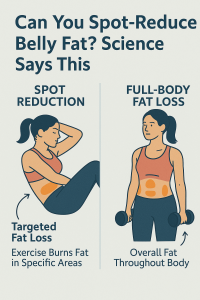Can You Spot-Reduce Belly Fat? Science Says This
If you’ve ever done hundreds of crunches hoping to flatten your belly, you’re not alone. The idea of “spot reduction” — losing fat in one specific area — is one of the most common fitness myths in the world.
But what does science say? Can you really target belly fat directly with ab workouts?
Let’s break down what decades of research reveal about spot reduction — and what actually works to lose fat from your midsection.
What Is Spot Reduction — and Why It’s So Popular

Spot reduction is the belief that you can burn fat from a specific area of your body — like your stomach, thighs, or arms — by exercising that area.
The Spot Reduction Myth Explained
It sounds logical: if you feel the burn in your abs, you must be melting fat there, right?
Unfortunately, that’s not how the body works. Exercise strengthens and tones muscles, but fat loss occurs systemically, not locally.
In simple terms:
You can’t tell your body where to burn fat — it decides for you.
The Origin of the Myth
The concept became popular in the 1980s and 1990s with the rise of infomercials and “ab-toning” products. Fitness marketers sold the idea that crunches, sit-ups, or vibrating belts could “melt belly fat.”
Science has since proven otherwise — yet the myth persists because visible muscle definition often follows overall fat loss, not targeted workouts.
How Fat Loss Actually Works
The Role of Energy Balance
Fat loss happens when your body burns more calories than it consumes. In this calorie deficit, your body draws stored fat from different areas simultaneously, depending on genetics, hormones, and energy needs.
How Your Body Chooses Where to Burn Fat
Your hormones and genetics determine your body’s “fat pattern.” Some people lose fat from their face first, others from their hips or chest. Unfortunately, the belly is usually the last to go — especially in adults over 30.
Why Belly Fat Is the Hardest to Lose
Belly fat is more than just a cosmetic issue — it’s a hormonal and metabolic issue.
The Role of Cortisol
Chronic stress raises cortisol, your body’s stress hormone, which triggers fat storage around the abdomen. This creates what experts call a “stress belly.”
Insulin Resistance and Midsection Fat
High sugar intake and irregular eating patterns cause insulin resistance, which prevents fat cells in the abdomen from releasing stored fat easily. This is why belly fat can persist even when you’re eating less.
What Science Says About Spot Reduction
Research on Ab Exercises and Fat Loss

A landmark study from the Journal of Strength and Conditioning Research found that doing ab exercises alone for six weeks did not reduce belly fat. Participants gained muscle endurance but no visible fat reduction in the abdomen.
Another study published in Medicine & Science in Sports & Exercise confirmed the same: you can’t selectively burn fat from one area through exercise.
What Really Works for Reducing Belly Fat
Science is clear: total-body fat loss is the only way to lose belly fat.
This means focusing on:
-
Full-body strength training
-
Cardio (especially HIIT)
-
Balanced nutrition and stress reduction
How to Actually Lose Belly Fat (Science-Backed Strategy)
1. Combine Strength and Cardio
Strength training builds muscle, which increases your resting metabolic rate, helping you burn more calories even at rest.
Pair it with HIIT workouts or moderate-intensity cardio (walking, cycling, swimming) for best results.
💡 Tip: A mix of 3 strength sessions + 2 cardio sessions per week = optimal fat loss balance.
2. Eat for Metabolic Health
-
Focus on lean proteins, fiber, and healthy fats (avocado, olive oil, fish).
-
Limit sugar and refined carbs, which spike insulin and promote fat storage.
-
Drink plenty of water — dehydration slows metabolism by up to 3–5%.
3. Sleep, Stress, and Hormone Balance
Poor sleep and chronic stress both elevate cortisol, slowing fat loss.
To optimize hormones:
-
Sleep 7–9 hours nightly.
-
Practice stress management (yoga, mindfulness, nature walks).
-
Maintain consistent mealtimes to regulate blood sugar.
Common Myths About Belly Fat and Exercise
| Myth | Reality |
|---|---|
| Crunches burn belly fat | They strengthen muscles but don’t reduce fat. |
| Sweating more means burning fat | Sweat is fluid loss, not fat loss. |
| Spot training works for abs | Fat loss occurs body-wide. |
| Women can’t lose belly fat after 40 | Hormones make it harder, but not impossible. |
| Supplements melt belly fat | No supplement replaces calorie deficit and movement. |
FAQs on Spot Reduction and Fat Loss
1. Can I lose belly fat by doing abs every day?
No. Ab exercises strengthen core muscles but don’t directly reduce fat.
2. Why do I Lose Weight everywhere except my stomach?
The abdomen is hormonally sensitive — cortisol and insulin make it the last place to lose fat.
3. What’s the fastest way to lose belly fat?
Combine strength training, HIIT, and a clean, high-protein diet consistently for 8–12 weeks.
4. Can I tighten my belly without losing fat?
Yes — core workouts can tone and define muscles underneath fat layers.
5. Does drinking more water help lose belly fat?
Yes — hydration improves metabolism, digestion, and fat mobilization.
6. Can genetics make belly fat harder to lose?
Yes. Your genetic “fat pattern” determines where fat is stored and burned first.
Conclusion: Train Smart, Not Local
So, can you spot-reduce belly fat?
👉 Science says no.
You can’t choose where your body burns fat — but you can influence how efficiently it burns overall.
When you focus on total-body strength, balanced nutrition, and hormone-friendly habits, belly fat will eventually follow. The secret isn’t more crunches — it’s smarter, science-based consistency.
Your abs aren’t built in a day — but with the right plan, they’re definitely in progress. 💪
👉 Learn more from Harvard Health – The Truth About Fat Loss.


